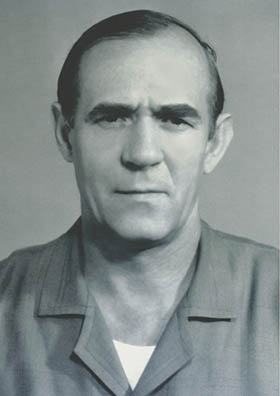Pavel Redin was born in Alexandrovsk (now Zaporozhye) in Ukraine. His grandfather Friedrich Redin, native of Germany, was descendant of colonists - pastoralists who inhabited the lands of the Russian Empire alongshore the Dnieper and Sea Azov by the decree of Catherine the Great. The artist's father, Fyodor Fridrikhovich Redin married a native-born Ukrainian Pelagia Grigorevne Nejiva. From their marriage were born three sons: Alexander, George and the youngest, the future artist, Pavel. Pavel's artistic talent was evident at an early age. He possessed a remarkable visual memory and a rare accurate eye. He subtly felt the polyphony of color. At first by coal, and later by pencil, he portrayed on paper the world around him.
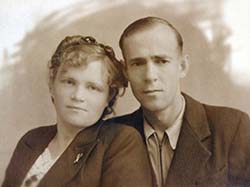
The creative life of Pavel Redin was unusual and many-sided. At sixteen Pavel headed the architectural department of Zaporozhye. Then he created first sketches for the reconstruction of the old part of the city. At the same time, he began attending the art school (at once entered the third year) at the Pedagogical Institute.
In 1934 Pavel went to Kharkov, where he successfully passed exams in the Kharkov Higher Art School. Later he enrolled in Kharkov art collage where studied in the studio of talented Ukrainian teachers Kryvnya M.M., Besedin S.F., Deregus M.G., which had big influence in the formation of his artistic views and professional development as an artist.
In May, 1941, Pavel Redin successfully graduated from college. His graduate work, a namely, picture "Happy Childhood" (which later became by an illustration to textbook of Russian literature for junior classes) has been recognized as the best graduate work among the graduates.
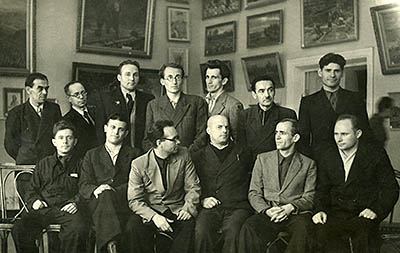
of the 2-nd Zaporizhzhya regional exhibitions.
Left to right: standing: Khabensky, Krukov, Goncharenko,
(unknown), (unknown), (unknown), Voloshin.
sitting: Plavkin, Gamol′skij, Kolosovsky, Stepanov, Redin, Stupin.
After graduation Pavel Redin returned to his hometown Zaporozhye. He was full of creative plans and high hopes. He dreamed about the organization of Society of Artists in Zaporizhia. But the young artist's plans did not come true because the Great Patriotic War, which began June 22, 1941, pushed back as much as four years of creative work of Pavel.
After the war and liberation of Zaporozhye from Nazi invaders, Redin worked with the newly organized museum in the department "Zaporozhye region during the occupation." The mainstream of his professional activity have been sketches, drawings and etudes of destroyed and recovering Zaporozhye, its industrial facility Zaporozhye Steel Plant “Zaporozhstal” and hydroelectric power station “DnieproHES”.
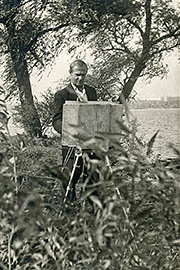
In 1946 Pavel Redin together with artists Evgeniy Chuikov and Georgiy Kolosovskiy initiated the creation of an association of artists at Municipal Committee of Zaporozhye, which later became the regional branch of the "Union of Artists of the Ukraine." In the studio of pictorial art "Unit of Artists" were invited promising young artists - Stupin V.E., Smirnov Y.A, Hayduk V.K., Volsky P.D., and others.
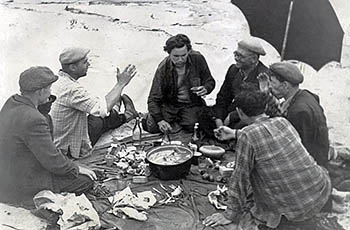
Left to right: U.Smirnov, P.Redin, E.Chuykov,
G.Kolosovsky, A.Fomin, M.Akinshin.
Pavel Redin believed that the forties and fifties were a period of his formation. At that time, he could develop his own unique style of displaying of life in art. Laborious and tireless work on himself; a legendary view of Hortitsa island and Baida island (which was an outpost of Zaporozhye Sech); charming bays and marshes of the Great Meadows, Upper and Lower Khortitsa; the blue expanse of the Dnieper; a golden arc of the DnieproHES - all contributed to the formation of the artist-patriot, a herald of beauty with the Ukrainian national undertone.
In his works he widely used oil paints, watercolor and gouache, pastel, charcoal and of course a pencil.
Since 1956, Pavel Redin was Chairman of the Arts Council of Zaporozhye Union of Artists (permanent), and member of the national board of the Union of Artists of Ukraine.
посвященная 1968 году, в которой рассказано
о юбилейной выставке П.Ф.Редина
Since 1959 he was member of the Union of Artists of USSR (Union of Soviet Socialist Republics).
Redin lived an active creative life, constantly participated in regional, republican, All-union and international exhibitions. His works are a treasury of Soviet-Ukrainian culture. Many of his paintings are represented in art and history museums of Ukraine, private collections and abroad. His creative achievements were awarded numerous diplomas, nominal gifts and the medal "For many years of hard work." On the canvases of his paintings can be seen Golden Ring of Russia, Siberia, the Crimea, the Carpathians and, of course, the Zaporozhye region with its legendary Zaporozhye Sech, the Hortitsa island, DnieproHES, and industrial facilities “Zaporozhstal”, “Dneprospecstal”, and “Koksokhim”, from which the industrialization of the country was began.
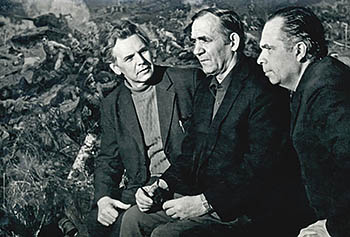
“At the final stage of the battle of Kursk (battle near Akhtyrka)”
Left to right: E.Chuykov, P.Redin, U.Smirnov.
In his picturesque heritage Pavel Redin described the image of the great motherland.
After the war, excavations of Scythian burials were resumed in Ukraine (especially in the eastern part). Museums tried to replenish their exhibits by antiquities most of which were looted or destroyed by the Nazis. At that time the main work of P.Redin were sketches of objects of graves. These sketches were attached to the reports of archaeological expeditions.
P. Redin recalled how after the sketches of objects from Scythian burial mounds he often dreamed events of those long-ago years. He not only saw the living and fighting warriors, but he was directly involved in these events. Perhaps, this is why the interpretation of events on his paintings was such truthful.
Pavel Redin created a number of magnificent, realistic, and unique art cycles as:
THE REVOLUTIONARY MOVEMENT IN ALEXANDROVSK;
ON CONSTRUCTION OF THE FIRST FIVE-YEAR PLAN;
LIBERATION FROM NAZI INVADERS IN UKRAINE (peintings and panoramas);
Pavel Redin died in Zaporozhye on March 13, 1992 and was buried on Pervomaiskiy cemetery.
